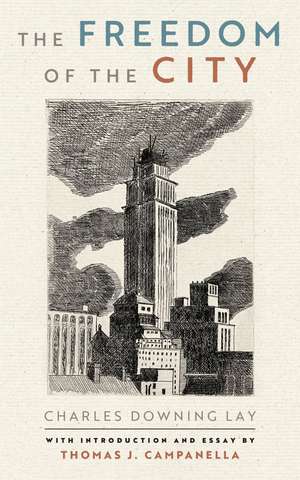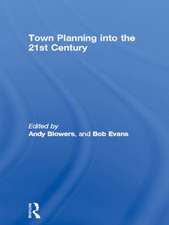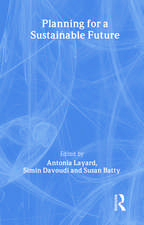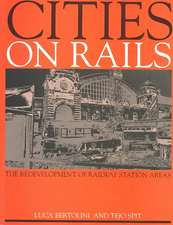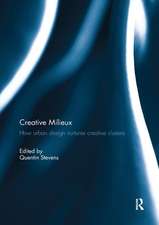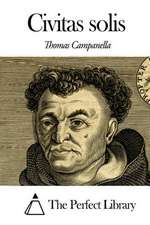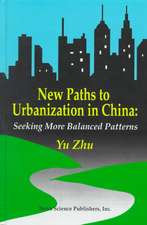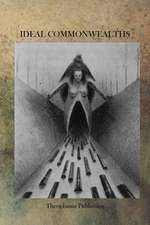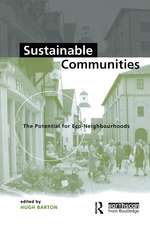The Freedom of the City
Autor Charles Downing Lay Introducere de Thomas Campanellaen Limba Engleză Paperback – 26 apr 2023
“Congestion is the life of the city . . . it is what we came for, what we stay for, what we hunger for”, wrote Charles Downing Lay, prominent American landscape architect and planner of the early 1920s. These words are relevant today as density and congestion are once again under siege, especially in our most productive and thriving cities.
Published in 1926, The Freedom of the City by Charles Downing Lay is an eloquent and timely defense of urbanism and city life. Award-winning author and urban historian Thomas J. Campanella has given Lay’s text new life and relevance, with the addition of explanatory notes, imagery, an introduction, and biographical essay, to bring this important work to a new generation of urbanists.
Lay was decades ahead of his time, writing The Freedom of the City as Americans were just beginning to fall in love with the automobile and leave town for a romanticized life on the suburban fringe. Planners and theorists were arguing that heavily congested cities were a form of cancer, that great metropolitan centers like London and New York City must be decanted into a leafy “garden cities” in the countryside. Lay saved his sharpest pen for these anti-urbanists in his own profession of city and regional planning.
Lay writes of the delights of city life and—especially—that importance of the singular, essential ingredient that makes it all possible: “congestion” (closest in definition to “density” today). Congestion, to Lay, is the secret sauce of cities, the singular element that gives London, Paris, or New York its dynamism and magic. He believed that the amenities and affordances of a city are “the direct result of its great congestion”; indeed, congestion is “the life of the city. Reduce it below a certain point and much of our ease and convenience disappears.
Campanella writes “for all his blind spots, Lay's core argument still obtains. The Freedom of the City was prescient in 1926 and timely now. Certainly, the essentials of good urbanism extolled in the book—human scale, diversity, walkability, the serendipities of the street; above all, density—are articles of faith among architects and urbanists today.”
Published in 1926, The Freedom of the City by Charles Downing Lay is an eloquent and timely defense of urbanism and city life. Award-winning author and urban historian Thomas J. Campanella has given Lay’s text new life and relevance, with the addition of explanatory notes, imagery, an introduction, and biographical essay, to bring this important work to a new generation of urbanists.
Lay was decades ahead of his time, writing The Freedom of the City as Americans were just beginning to fall in love with the automobile and leave town for a romanticized life on the suburban fringe. Planners and theorists were arguing that heavily congested cities were a form of cancer, that great metropolitan centers like London and New York City must be decanted into a leafy “garden cities” in the countryside. Lay saved his sharpest pen for these anti-urbanists in his own profession of city and regional planning.
Lay writes of the delights of city life and—especially—that importance of the singular, essential ingredient that makes it all possible: “congestion” (closest in definition to “density” today). Congestion, to Lay, is the secret sauce of cities, the singular element that gives London, Paris, or New York its dynamism and magic. He believed that the amenities and affordances of a city are “the direct result of its great congestion”; indeed, congestion is “the life of the city. Reduce it below a certain point and much of our ease and convenience disappears.
Campanella writes “for all his blind spots, Lay's core argument still obtains. The Freedom of the City was prescient in 1926 and timely now. Certainly, the essentials of good urbanism extolled in the book—human scale, diversity, walkability, the serendipities of the street; above all, density—are articles of faith among architects and urbanists today.”
Preț: 197.93 lei
Nou
Puncte Express: 297
Preț estimativ în valută:
37.87€ • 39.64$ • 31.52£
37.87€ • 39.64$ • 31.52£
Carte disponibilă
Livrare economică 10-24 martie
Preluare comenzi: 021 569.72.76
Specificații
ISBN-13: 9781642832952
ISBN-10: 1642832952
Pagini: 168
Ilustrații: 20 photos-illustrations
Dimensiuni: 127 x 203 x 15 mm
Greutate: 0.2 kg
Editura: Island Press
Colecția Island Press
ISBN-10: 1642832952
Pagini: 168
Ilustrații: 20 photos-illustrations
Dimensiuni: 127 x 203 x 15 mm
Greutate: 0.2 kg
Editura: Island Press
Colecția Island Press
Notă biografică
Charles Downing Lay (1877-1956) was a landscape architect, city planner, artist, author, and essayist. Born in the Hudson Valley and raised in New York City, he studied with Frederick Law Olmsted, Jr. at Harvard before taking a leadership post with the New York City Department of Parks.
Thomas J. Campanella is Professor of City and Regional Planning at Cornell University and Historian-in-Residence of the New York City Parks Department. He has held Guggenheim and Fulbright fellowships and is a Fellow of the American Academy in Rome. His most recent book, Brooklyn: The Once and Future City (2019), was a finalist for the Brendan Gill Prize from the Municipal Arts Society of New York.
Thomas J. Campanella is Professor of City and Regional Planning at Cornell University and Historian-in-Residence of the New York City Parks Department. He has held Guggenheim and Fulbright fellowships and is a Fellow of the American Academy in Rome. His most recent book, Brooklyn: The Once and Future City (2019), was a finalist for the Brendan Gill Prize from the Municipal Arts Society of New York.
Cuprins
Introduction: The Necessity for Congestion by Thomas J. Campanella
The Life and Work of Charles Downing Lay by Thomas J. Campanella
The Freedom of the City by Charles Downing Lay
Notes
Index
About the Authors
The Life and Work of Charles Downing Lay by Thomas J. Campanella
The Freedom of the City by Charles Downing Lay
Notes
Index
About the Authors
Recenzii
"Campanella’s revival of The Freedom of the City spotlights our perennial amnesia regarding the value of urban density. Every generation of Americans, it seems, needs reminding that the city—crowded, congested, and often chaotic—is also a place of joyous social friction. As many again question the relevance of urbanism in this new age of hybrid work, Lay and Campanella remind us that true freedom emanates from city streets, not glowing screens."
"Long-forgotten landscape architect Charles Downing Lay’s passion for all things city is brilliantly rediscovered by urbanist Tom Campanella. Campanella’s elegantly composed introduction and essay alone are worth the price of admission."
"Thank you, Tom Campanella, for unearthing The Freedom of the City and adding some much-needed fuel to the urbanist cause. NIMBYism rages on, stoking tragically unsustainable anti-urban rhetoric, and books like this help us keep up the good fight. We need to love our cities fiercely. What this book shows is that the reason to collect ourselves in dense, walkable cities is not just because we have to, but because we want to."
Descriere
Published in 1926, The Freedom of the City by Charles Downing Lay is an eloquent and timely defense of urbanism and city life. Award-winning author and urban historian Thomas J. Campanella has given Lay’s text new life and relevance, with the addition of explanatory notes, imagery, an introduction, and biographical essay, to bring this important work to a new generation of urbanists.
Campanella writes “The Freedom of the City was prescient in 1926 and timely now. Certainly, the essentials of good urbanism extolled in the book—human scale, diversity, walkability, the serendipities of the street; above all, density—are articles of faith among architects and urbanists today.”
Lay’s words are relevant today as density and congestion are once again under siege, especially in our most productive and thriving cities.
Campanella writes “The Freedom of the City was prescient in 1926 and timely now. Certainly, the essentials of good urbanism extolled in the book—human scale, diversity, walkability, the serendipities of the street; above all, density—are articles of faith among architects and urbanists today.”
Lay’s words are relevant today as density and congestion are once again under siege, especially in our most productive and thriving cities.
